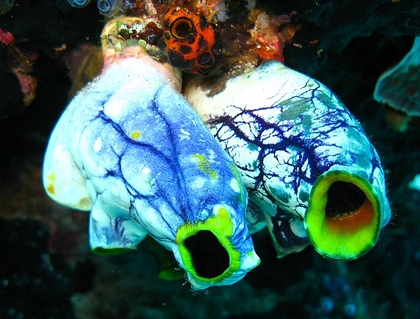| The Surreal Diversity of the Tunicates |
If sea-squirts and oozoids look like creatures from an alien world, the larvaceans could hail from some
parallel dimension. What you are looking at in the above image is a delicate, nearly invisible structure
of pure mucus more than six feet across....created and propelled an animal barely an inch in length.
Larvaceans are so named because they retain the larval "tadpole" form of a tunicate for their entire
lives, though virtually nothing is known about their reproduction.
Each and every single day, a larvacean generates enough mucus to construct a "vehicle" up to
several hundred times its size, a marvel of biological engineering that puts our own early sea-faring
vessels to shame:
parallel dimension. What you are looking at in the above image is a delicate, nearly invisible structure
of pure mucus more than six feet across....created and propelled an animal barely an inch in length.
Larvaceans are so named because they retain the larval "tadpole" form of a tunicate for their entire
lives, though virtually nothing is known about their reproduction.
Each and every single day, a larvacean generates enough mucus to construct a "vehicle" up to
several hundred times its size, a marvel of biological engineering that puts our own early sea-faring
vessels to shame:
With millions of these animals discarding millions of huge houses a day, it should come as no
surprise that they have a significant impact on marine ecology; as their old homes slowly sink, they
collect even more organic particles and deliver a significant amount of food to even the most
remote and barren depths of the sea, making these animals incredibly important to the inhabitants
of the deep sea abyss.
By now, some of you should be feeling at least a little enlightened about our quirkiest chordate
cousins, but this page is far from complete. There are many other variations on your basic
sea-squirts and salps, and there are always new species awaiting discovery.
surprise that they have a significant impact on marine ecology; as their old homes slowly sink, they
collect even more organic particles and deliver a significant amount of food to even the most
remote and barren depths of the sea, making these animals incredibly important to the inhabitants
of the deep sea abyss.
By now, some of you should be feeling at least a little enlightened about our quirkiest chordate
cousins, but this page is far from complete. There are many other variations on your basic
sea-squirts and salps, and there are always new species awaiting discovery.
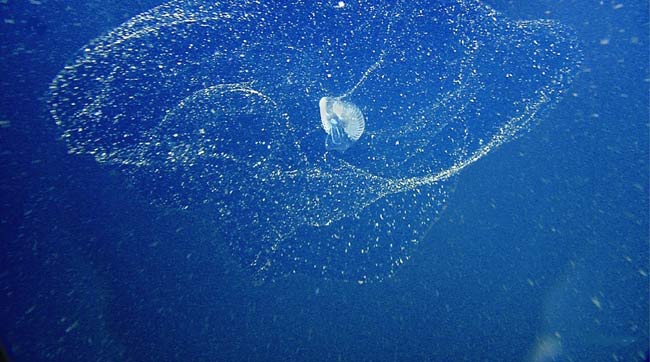
Known as a "fishing house," this ingenious structure is steered through the water by no more than the
wriggling of its occupants tiny tail. As it moves, water passes through two sets of filters; one to keep
large particles from entering the house and a finer, interior set that traps the animal's food. A lower
intake helps stabilize mobility in the sea's current, and the "exhaust" hole is also employed as an
emergency exit should the vessel be attacked. Every night, debris builds up in the fishing house until it
needs to be discarded, and every night the simple-minded tadpole spins one anew.
wriggling of its occupants tiny tail. As it moves, water passes through two sets of filters; one to keep
large particles from entering the house and a finer, interior set that traps the animal's food. A lower
intake helps stabilize mobility in the sea's current, and the "exhaust" hole is also employed as an
emergency exit should the vessel be attacked. Every night, debris builds up in the fishing house until it
needs to be discarded, and every night the simple-minded tadpole spins one anew.
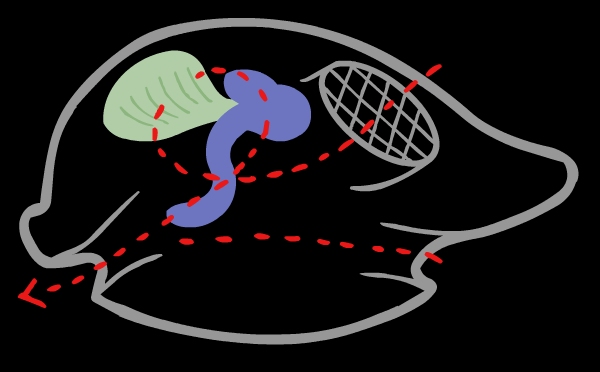
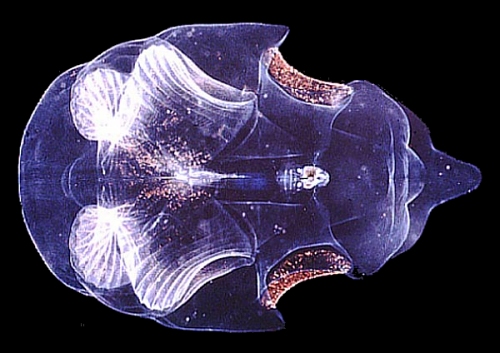
| Photo copyright MBARI |
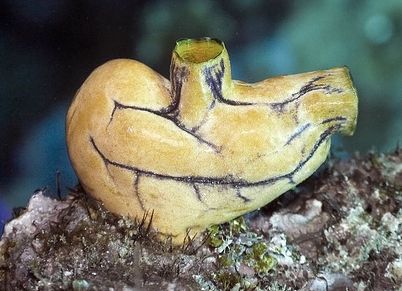
What resembles a disembodied, gelatinous stomach on the sea floor is one of the simplest, most
ancient animals on our planet, and more related to you or I than any jellyfish or sponge. These
creatures are not considered invertebrates at all, but are grouped within the Chordata, right
alongside animals with spinal columns.
This rubbery blob is just one example of a tunicate, and arguably the least peculiar form that
these amazing animals come in.
ancient animals on our planet, and more related to you or I than any jellyfish or sponge. These
creatures are not considered invertebrates at all, but are grouped within the Chordata, right
alongside animals with spinal columns.
This rubbery blob is just one example of a tunicate, and arguably the least peculiar form that
these amazing animals come in.
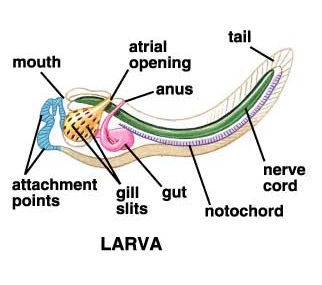
All tunicates begin their lives in a "tadpole" stage, during which they share many qualities
unique to a vertebrate embryo, the most significant of which is the notochord; in fish,
amphibians, reptiles, birds and mammals, this flexible rod develops into the spinal column.
Like barnacles, the final purpose of the larval stage is often to find a nice feeding spot and
drop anchor permanently. After gluing itself to a solid surface head-down, the tunicate begins
to lose what it will no longer need as a sedentary glob, digesting its notochord and even most
of its own brain in the process.
unique to a vertebrate embryo, the most significant of which is the notochord; in fish,
amphibians, reptiles, birds and mammals, this flexible rod develops into the spinal column.
Like barnacles, the final purpose of the larval stage is often to find a nice feeding spot and
drop anchor permanently. After gluing itself to a solid surface head-down, the tunicate begins
to lose what it will no longer need as a sedentary glob, digesting its notochord and even most
of its own brain in the process.
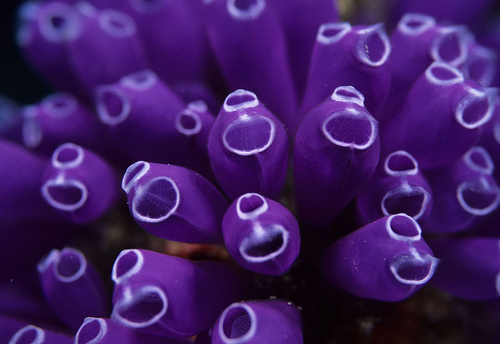
The common adult shape we've already seen is often called a sea squirt, which will spend the
rest of its life sucking water into its upper mouth orifice and out the lower anal vent. Inside lies
a beating heart, a gut, gonads and gills. To reproduce, they simply eject sperm into the water
around them.
rest of its life sucking water into its upper mouth orifice and out the lower anal vent. Inside lies
a beating heart, a gut, gonads and gills. To reproduce, they simply eject sperm into the water
around them.
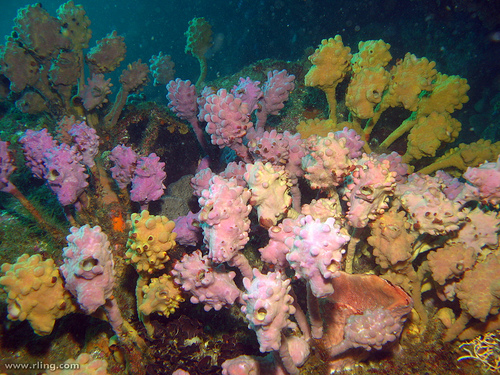
There are many variations on the basic sea squirt. These long-necked weirdos are often
called "sea tulips," and are actually colored by a layer of symbiotic sponge. Other tiny squirts
grow together in colonies that resemble globs of jelly or clusters of bubbles - "sea pork" and
"sea grapes."
called "sea tulips," and are actually colored by a layer of symbiotic sponge. Other tiny squirts
grow together in colonies that resemble globs of jelly or clusters of bubbles - "sea pork" and
"sea grapes."
Particularly exciting are those sea squirts with an appetite for more than just microscopic
plankton; Megalodicopia hians grows in the deep, dark oceanic abyss, where its siphoning
system has been heavily modified into a deceptively adorable mouth. Standing like a sinister
satellite dish in the abyssal current, it waits for tiny animals to blunder their way into its trap,
closing over and digesting them like a carnivorous plant.
plankton; Megalodicopia hians grows in the deep, dark oceanic abyss, where its siphoning
system has been heavily modified into a deceptively adorable mouth. Standing like a sinister
satellite dish in the abyssal current, it waits for tiny animals to blunder their way into its trap,
closing over and digesting them like a carnivorous plant.
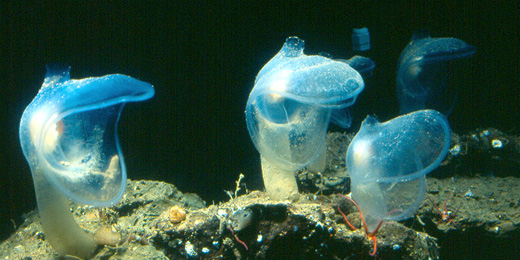
| Photo from the Monterey Bay Aquarium |
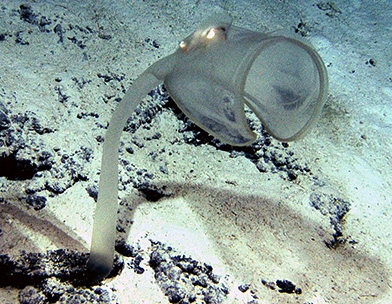
A second species of meat-eating squirt was discovered as recently as 2009, when it was filmed
for the first time in deep Tasmanian waters. As you can see, this variety chooses an entirely
different "mouth" shape, considerably less anthropomorphic but no less fascinating.
for the first time in deep Tasmanian waters. As you can see, this variety chooses an entirely
different "mouth" shape, considerably less anthropomorphic but no less fascinating.
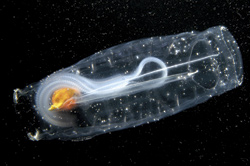
| The Salps |
Sea squirts on the go, adult salps actually swim through the water by repetitive jellyfish-like
contraction, with most species feeding on phytoplankton (microscopic plant life). Their life
cycle is entirely unique in the animal kingdom, including even other tunicates; this solitary
individual bears the super-cool name Oozoid, and reproduces asexually. It produces dozens
or even hundreds of tiny clones which eventually break off in one long, connected chain.
contraction, with most species feeding on phytoplankton (microscopic plant life). Their life
cycle is entirely unique in the animal kingdom, including even other tunicates; this solitary
individual bears the super-cool name Oozoid, and reproduces asexually. It produces dozens
or even hundreds of tiny clones which eventually break off in one long, connected chain.
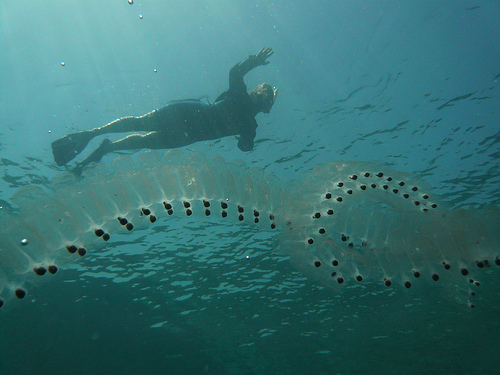
The chain of salps do not mature into Oozoids, but continue to grow as a connected group
known as the also-cool-sounding Blastozooid, which in some cases can approach the length
of your average whale. The salps in a blastozooid reproduce sexually, switching from male to
female as they impregnate one another in sequence. Each one will produce an oozoid, which
swims away to generate another blastozooid, and so forth. Though seldom discussed, these
are actually among some of the most plentiful animals in the sea, rivaling krill in their impact on
the food chain.
known as the also-cool-sounding Blastozooid, which in some cases can approach the length
of your average whale. The salps in a blastozooid reproduce sexually, switching from male to
female as they impregnate one another in sequence. Each one will produce an oozoid, which
swims away to generate another blastozooid, and so forth. Though seldom discussed, these
are actually among some of the most plentiful animals in the sea, rivaling krill in their impact on
the food chain.
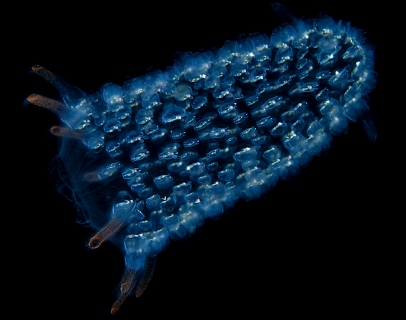
Related to the salps but dramatically different are the Pyrosoma, which consist of extremely
tiny tunicates joined in a rubbery "tunic." The colony is propelled by the combined pulsations of
hundreds or even millions of individuals, with some species known to exceed fifty feet in total
length. Most pyrosomes are spectacularly luminescent, said to produce the brightest and most
sustained light of any organism in nature. What use they actually have for this light is not fully
understood.
tiny tunicates joined in a rubbery "tunic." The colony is propelled by the combined pulsations of
hundreds or even millions of individuals, with some species known to exceed fifty feet in total
length. Most pyrosomes are spectacularly luminescent, said to produce the brightest and most
sustained light of any organism in nature. What use they actually have for this light is not fully
understood.
| The Larvaceans |
